One of the latest locomotives to debut on North American rails, the General Electric ET44, joins the ScaleTrains.com HO scale roster. I reviewed a top-of-the-line Rivet Counter GE ET44AH that includes roadname and number-specific detailing and a factory-installed dual-mode ESU LokSound decoder. Like other ScaleTrains.com models, a value-priced, Digital Command Control (DCC)-ready Operator version with simplified detailing is also available.
The prototype. Part of GE’s Evolution-series (or GEVO), the ET44 was designed to meet the Environmental Protection Agency’s strict Tier 4 emissions standards. Like its predecessor, the ES44 introduced in 2004, the ET44 has a 4,400-hp, 12-cylinder GEVO diesel engine, Hi-Adhesion trucks, and a wide-nosed “Safety” cab. The ET44 has a longer frame and larger radiator section than the ES44. The GEVO Tier 4’s advanced emissions treatment equipment also requires a boxy enclosure that surrounds its exhaust stack. On early production units, this enclosure stretched over the engine compartment.
To date General Electric has built 899 of the Tier 4 GEVOs, most classed ET44AC. The BNSF GEVOs ride on A1A trucks (two powered outside axles and an unpowered center axle) and are classed ET44C4. Both CSX and Union Pacific have “heavy” versions, classed ET44AH and C45AH, respectively.
The model. The model’s dimensions match a prototype drawing in Locomotive 2017 (Kalmbach Publishing Co.) All the well-defined molded detail matches prototype photos, including engine access doors and panel seams. There’s tread detail along the walkways and see-through tread on the pilot steps.
The Rivet Counter model features accurately placed separate detail parts, including m.u. hoses and cables, and uncoupling levers. There’s even a tow chain along the sill and rotating bearing caps on the trucks. The air intake and dynamic brake intake grills are see- through, with radiator and blower motors visible inside, respectively. Correct per the prototype, there’s a separate antenna dome on the cab roof.
Although there aren’t any crew figures, the cab interior is fully detailed with seats, a control stand, tinted windows, and separate windshield wipers.
The model is smoothly painted in the correct shades of CSX blue and yellow. The placement of the lettering, CSX logo, and every stencil matches prototype photos of no. 3250. The et44ah classification is correctly placed on both sides of the cab in front of the lightning bolts.
Mechanism. After removing the front and rear couplers, I carefully lifted off the plastic body shell. A dual-flywheel-equipped motor rests in the center of the die-cast metal chassis and powers the truck-mounted gear boxes. Another die-cast metal weight runs the length of the locomotive.
The motherboard is screwed to the top of the weight, while the ESU LokSound 4.0 decoder is plugged into the board’s 21-pin socket. Leads run from the motherboard to surface-mount light-emitting diodes (LEDs) that illuminate the headlights and ditch lights.
Two cube-type speakers are housed inside a die-cast metal enclosure screwed to the weight above the rear truck.
Also shown in the chart is the model’s impressive drawbar pull. The HO Tier 4 also hauled 17 HO freight cars up a 3 percent grade without slipping.
To test its minimum radius, I ran the Tier 4 around a circle of 18″ radius set track without any difficulty. However, the model looks much more realistic rounding 22″ radius or greater curves.
The decoder also includes the ESU PowerPack capacitor system to keep the sounds, lights, and operation steady over short stretches of dirty or uneven track. The PowerPack allows about 4 seconds of operation without track power.
DCC performance. The LokSound decoder’s Full Throttle effects package provides a hands-on operating experience. I could simulate the sounds and motion of a locomotive drifting light through a yard, hauling a loaded train upgrade, or anything in between.
A button-controlled, brake function allowed for realistic stops without having to use the throttle knob.
The drive/hold feature let me manually notch the engine sound using the throttle knob, while keeping the speed at its current setting. I find this arrangement more reliable to use than the button-controlled manual notching of earlier LokSound decoders. There’s also a separate run 8 feature that sets the sound to maximum rpm, or notch 8, when the locomotive starts out.
Opposite of the drive/hold function is the coast function, where the engine sound stays at idle and the knob controls the speed. This is useful for simulating a locomotive drifting downgrade. Also useful for going downhill is a separate dynamic brake effect that includes the engine dropping in rpm and the whirring sound of the cooling fans.
When I pressed function 2, the air horn and E bell sounded while the ditch lights alternately flashed, which is correct for the CSX prototype. Other user-triggered sound effects include radiator fans, engine start up, and coupler crash. The ditch lights and headlight are independently controlled.
Pressing function 5 sets the locomotive headlight in the opposite direction of travel to dim, while turning off the other headlight. This feature is used when the locomotive is at the end of the train as part of a Distributed Power Unit (DPU) consist.
Every lighting, sound, and performance aspect of the decoder can be adjusted via configuration variables (CVs). Using an ESU LokProgrammer computer interface (sold separately), I changed the locomotive address, added acceleration and deceleration momentum, advance consisted two Tier 4 locomotives, and set up consist functions.
Even without the LokProgrammer hardware, using the free downloadable LokProgrammer software is the easiest way to program the indexed CVs used by ESU decoders. Simply make the programming changes on the computer screen, click the show changed cvs option, then manually enter the CVs into the DCC system.
DC performance. When run with a DC power pack, most of the locomotive’s sound effects are automatic. The headlights and ditch lights operate according to the locomotive’s direction of travel, and the engine rpm sounds go up and down with the throttle setting. The built-in momentum added realism. As long as I kept the throttle at 6V, the sounds remained steady, even when I brought the locomotive to a stop.
Museum-quality modeling and a mechanism that runs like a Swiss watch make the ScaleTrains.com GEVO Tier 4 a worthy HO model of its present-day prototype.
Prices: Rivet Counter version: first run, $224.99, second run, $229.99 (DCC sound); $149.99 (DC, no sound)
Operator version: $99.99 (DC, no sound)
Manufacturer
ScaleTrains.com Inc.
7598 Highway 411
Benton, TN 37307
www.scaletrains.com
Era: 2012 to present
Road names (multiple road numbers and paint schemes available): CSX, BNSF, Canadian National, General Electric demonstrator, Norfolk Southern, ScaleTrains.com, and Union Pacific
Features
• 21-pin DCC plug
• All-wheel-drive and electrical pickup
• Blackened metal wheels in gauge
• Drill starter points for grab irons, m.u. hoses, and other not-included detail parts (Operator version)
• Dual-mode ESU LokSound 4.0 decoder with Full Throttle effects package (DCC version)
• ESU PowerPack capacitor (DCC version)
• Five-pole, skew-wound motor with dual brass flywheels
• Light-emitting diode headlights
• Minimum radius: 18″ (22″ recommended by manufacturer)
• Operates on codes 70, 83, and 100 rail
• ScaleTrains.com metal semi-scale Type E knuckle couplers, mounted at correct height (Operator version has plastic knuckle couplers)
• Weight: 1 pound, 10.3 ounces





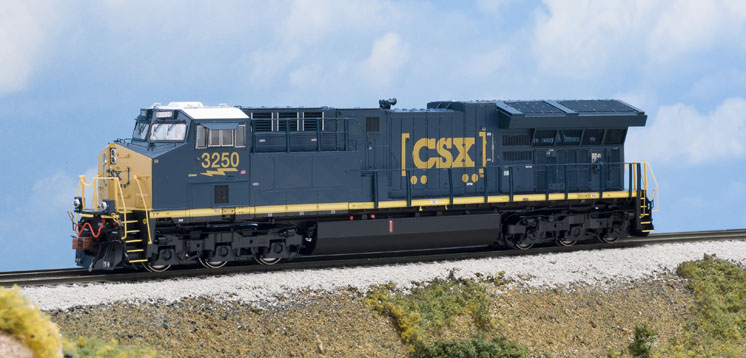
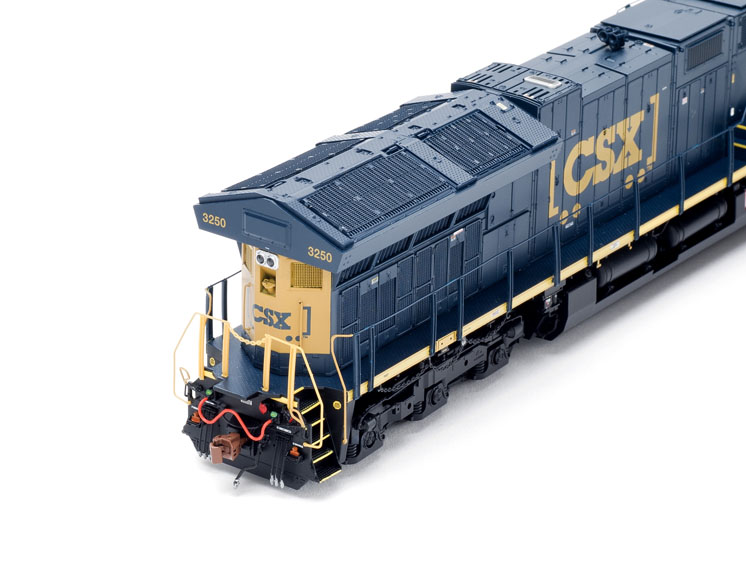

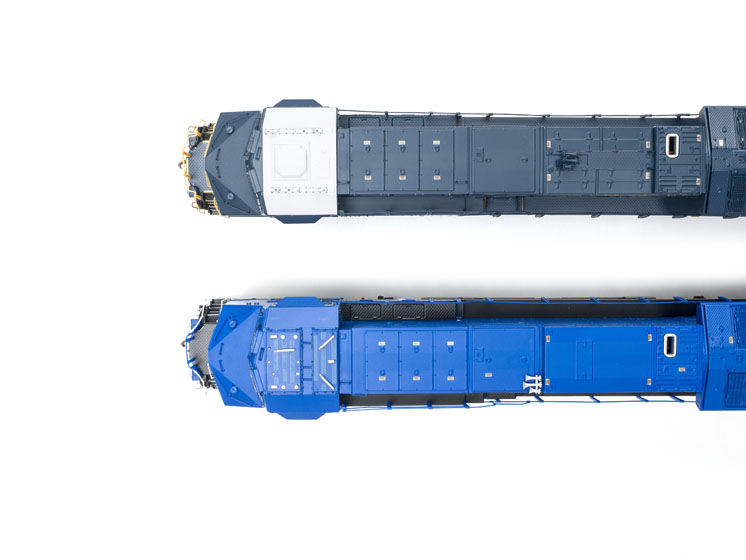
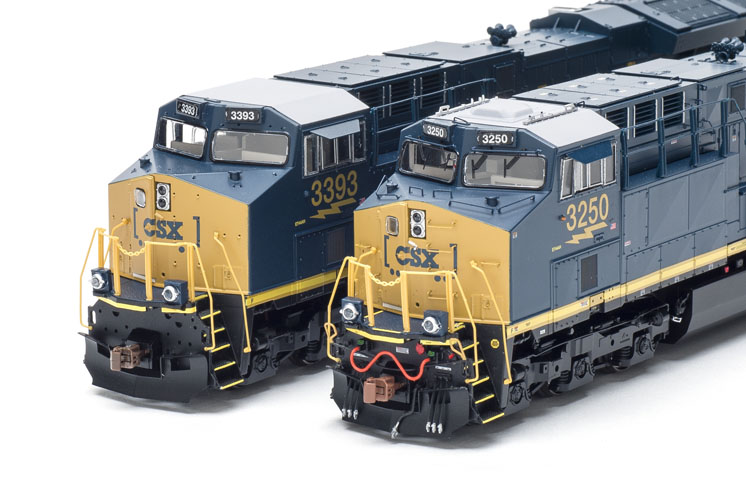

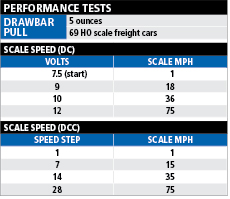









ScaleTrains provides their own coupler design, which has no gladhand. I was able to substitute Kadee non-whisker semi-scale couplers into the ScaleTrains coupler box.
I suggest that in future reviews of models with homemade couplers (Rapido?) you include a note about ease of coupler substitution with that scale’s standard.
Dana,
As has been pointed out to me by a friend, I now see that the tow chain is CSX-specific. It’s a nice piece of usually missed detail.
I would still prefer Scale Trains use a piece of scale chain for the hand brake and also the tow chain on the CSX models. At least on my CN units I only have one to change. 🙂
Dana,
You mention a ‘tow chain’ in your review. I believe this is actually the hand brake chain connecting the handbrake wheel to the brake cylinder on the rear truck.
Scale Trains chose to implement this detail with cast plastic parts while Intermountain used actual scale chain on their ET44.
This is the one detail I will modify on my ST CN units, I think the scale chain looks better that the plastic representation.
CN models also have the open mesh walkways as used on the prototype to prevent snow build-up.
Hi John,
Yes it does. Most decoders these days are “dual mode” in that they operate on both DCC and DC layouts. You should note though that sound effects and other programmable features available on sound decoders will be limited when the locomotive is run with a DC power pack.
Thanks for reading
Dana Kawala
Senior editor
Model Railroader magazine
Does the DCC version operate on both DCC and DC layouts? Sorry, just new to the hobby.